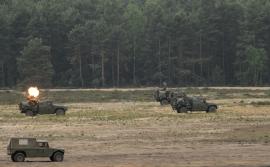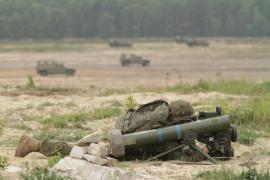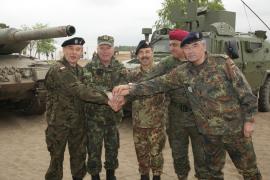- Home
- Latest News
- Exhibición de medios militares de la Alianza en el campo de maniobras polaco de Zagan
Exhibition of NATO military equipment at the Zagan training area in Poland
Thursday, May 26, 2016
Number: 5261
The star of the Alliance

Deployment of the Spanish unit in the exercise (Photo: Ángel Tejedor/DECET)

The BRILAT contributes the bulk of the troops (Photo: Ángel Tejedor/DECET)

The top brass displaying their unity (Photo: Ángel Tejedor/DECET)
Distinguished Visitors Day (DVD), which took place on 25 May at Wroclaw airport and the Zagan training area in Poland, proved to be a great success among the senior military officers from NATO who attended. It was also an enjoyable experience for the journalists invited to take part in an organised tour and check out the capabilities of the Very High Readiness Joint Task Force (VJTF) which will be activated in 2016 in case of need. There were members of the media from different European countries (Albania, Denmark, Germany, Poland, Rumania, Spain and the UK) and they were able to pose questions to the military authorities at the end of the event.
In the dynamic deployment there was a British company on the right: The 2nd Battalion of the Mercian Regiment. It had come into contact with the enemy and was firing with light weapons to fix it in place. The next to arrive, from the left, were the Spanish soldiers of the ‘San Quintín’ Battalion, from the 7th Light Infantry Brigade ‘Galicia’ (known as BRILAT). They fired different weapons from their High Tactical Mobility Vehicles or on foot. In the meantime, Spanish engineers drove a wedge into the enemy, which had laid anti-personnel landmines, to ensure that it did not hinder further the advance of the troops. Precision shooters from the Albanian 1st Infantry Company entered the scene to support the engineers and offer them protection. However, adverse weather conditions prevented the flight of the US Apaches, whose task it would have been to harass the enemy. When smokescreen covered the battlefield and all that could be heard was the sound of bullets, the Leopard 2A tanks of the host nation contributed the firepower needed to bring the battle to an end.
Before the simulation there was a press conference to explain the composition of the VJTF and the phases of exercise Brilliant Jump, during which the generals attending the DVD addressed the media. Army General Salvatore Farina, Allied Joint Force Commander Brunssum, highlighted "Spain’s effort" to transport to Poland 1,300 soldiers, 476 vehicles and 70 containers, which took place through air and sea and required both military and civilian resources. According to Lt. Gen. Francisco Javier Valera, the Spanish deployment makes up 30% of the forces made available to the Alliance.” He also declared he was very pleased “at the levels of training achieved and at having met all the milestones which had been identified.” General Luis Cebrián, commander of BRILAT (which contributes the bulk of the forces to the VJTF), explained that for over a year the brigade “has been coordinating the different elements of the process in order to guarantee their coordination and has created a series of procedures to ensure integration and interoperability.”
At the end of the exercise General Farina and General Mieczyslaw Gocul, Chief of the General Staff of the Polish Armed Forces, gave a press conference in which they stressed that the these exercises serve to make it clear that “together, we are stronger” and that NATO is “ready to respond to any aggression”. Once again, the VJTF appears as “the star of the Alliance”.
ARMY UNITS
- Araba Álava |
- Albacete |
- Alicante |
- Almería |
- Asturias |
- Ávila |
- Badajoz |
- Barcelona |
- Burgos |
- Cáceres |
- Cádiz |
- Cantabria |
- Castellón |
- Ceuta |
- Ciudad Real |
- Córdoba |
- A Coruña |
- Cuenca |
- Girona |
- Granada |
- Guadalajara |
- Gipuzkoa |
- Huelva |
- Huesca |
- Islas Baleares |
- Jaén |
- León |
- Lleida |
- Lugo |
- Madrid |
- Málaga |
- Melilla |
- Murcia |
- Navarra |
- Ourense |
- Palencia |
- Las Palmas |
- Pontevedra |
- La Rioja |
- Salamanca |
- Segovia |
- Sevilla |
- Soria |
- Tarragona |
- Santa Cruz de Tenerife |
- Teruel |
- Toledo |
- Valencia |
- Valladolid |
- Bizkaia |
- Zamora |
- Zaragoza



